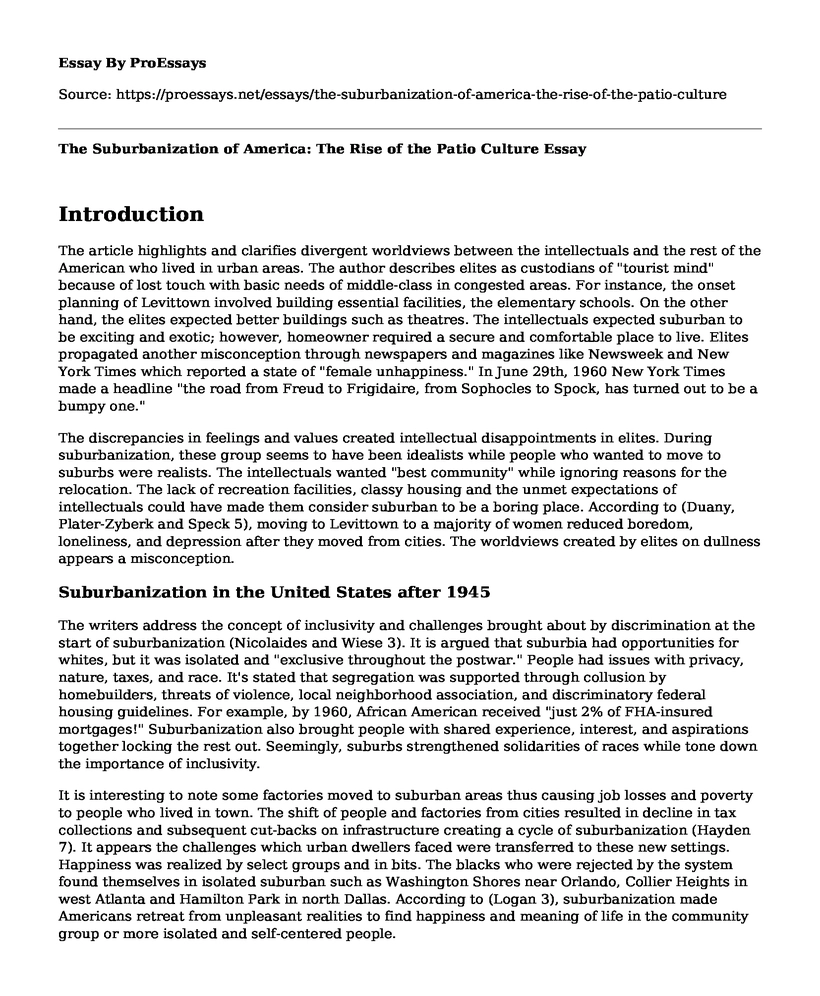Introduction
The article highlights and clarifies divergent worldviews between the intellectuals and the rest of the American who lived in urban areas. The author describes elites as custodians of "tourist mind" because of lost touch with basic needs of middle-class in congested areas. For instance, the onset planning of Levittown involved building essential facilities, the elementary schools. On the other hand, the elites expected better buildings such as theatres. The intellectuals expected suburban to be exciting and exotic; however, homeowner required a secure and comfortable place to live. Elites propagated another misconception through newspapers and magazines like Newsweek and New York Times which reported a state of "female unhappiness." In June 29th, 1960 New York Times made a headline "the road from Freud to Frigidaire, from Sophocles to Spock, has turned out to be a bumpy one."
The discrepancies in feelings and values created intellectual disappointments in elites. During suburbanization, these group seems to have been idealists while people who wanted to move to suburbs were realists. The intellectuals wanted "best community" while ignoring reasons for the relocation. The lack of recreation facilities, classy housing and the unmet expectations of intellectuals could have made them consider suburban to be a boring place. According to (Duany, Plater-Zyberk and Speck 5), moving to Levittown to a majority of women reduced boredom, loneliness, and depression after they moved from cities. The worldviews created by elites on dullness appears a misconception.
Suburbanization in the United States after 1945
The writers address the concept of inclusivity and challenges brought about by discrimination at the start of suburbanization (Nicolaides and Wiese 3). It is argued that suburbia had opportunities for whites, but it was isolated and "exclusive throughout the postwar." People had issues with privacy, nature, taxes, and race. It's stated that segregation was supported through collusion by homebuilders, threats of violence, local neighborhood association, and discriminatory federal housing guidelines. For example, by 1960, African American received "just 2% of FHA-insured mortgages!" Suburbanization also brought people with shared experience, interest, and aspirations together locking the rest out. Seemingly, suburbs strengthened solidarities of races while tone down the importance of inclusivity.
It is interesting to note some factories moved to suburban areas thus causing job losses and poverty to people who lived in town. The shift of people and factories from cities resulted in decline in tax collections and subsequent cut-backs on infrastructure creating a cycle of suburbanization (Hayden 7). It appears the challenges which urban dwellers faced were transferred to these new settings. Happiness was realized by select groups and in bits. The blacks who were rejected by the system found themselves in isolated suburban such as Washington Shores near Orlando, Collier Heights in west Atlanta and Hamilton Park in north Dallas. According to (Logan 3), suburbanization made Americans retreat from unpleasant realities to find happiness and meaning of life in the community group or more isolated and self-centered people.
How Suburbanization Was Sold
According to this video (city lab), life in suburbia is like any other life; it had pleasing and displeasing moments. Some people were degraded other discouraged; some ignored while others were happy to be in these places; however, everyone had the desire to own their properties. The recreation areas in the clip bring the idea of a stable and settled situation. It seems elites valued suburban homes "as a refuge from work, as a source of goodness." The suburbs embodied the achievement of above-average life; was predictable, harmonious and part of the dreamy constellation. The upper-class status built mansions in lush suburban environments. The idea that the "slums of today were suburbs of yesterday" points to an agreeable position that people endeavor to create new cities from scratch with parks and recreation areas, church, shops, schools all for good residential living.
Works Cited
Citylab. "Archival Films Reveal How The Suburbanization Of America Was Sold." CityLab. N.p., 2015. Web. 22 June 2018.
BIBLIOGRAPHY Duany, A, E Plater-Zyberk and J Speck. Suburban Nation: The Rise of Sprawl and the Decline of the American Dream. New York: North Point Press, 2001.
Hayden, D. Building Suburbia: Green Fields and Urban Growth, 18202000. New York: Pantheon Books, 2003.
Knight, Greg. "The Suburbanization of America: The Rise of the Patio Culture." Patioculture.net. N.p., 2014. Web. 22 June 2018.
Logan, J. "Separate and unequal in suburbia." Census brief prepared for US2010. 2014.
Nicolaides, Becky and Andrew Wiese. "Suburbanization in the United States after 1945." Urban History (2017): 2-6.
Cite this page
The Suburbanization of America: The Rise of the Patio Culture. (2022, Jun 22). Retrieved from https://proessays.net/essays/the-suburbanization-of-america-the-rise-of-the-patio-culture
If you are the original author of this essay and no longer wish to have it published on the ProEssays website, please click below to request its removal:
- Europe Before World War II - Critical Thinking Example
- A Rationale for Why They Chose This Family
- Should the US Have Joined World War 1 - Essay Sample
- Essay Sample on Diversity in the Workplace Environment
- Paper Example on The Digital Revolution: Making the World a Village
- Essay Sample on Race & Social Construct: W.E.B. Dubois' Color Line, Veil Theories
- Essay Sample on Importance of Rivers in First Civilization







